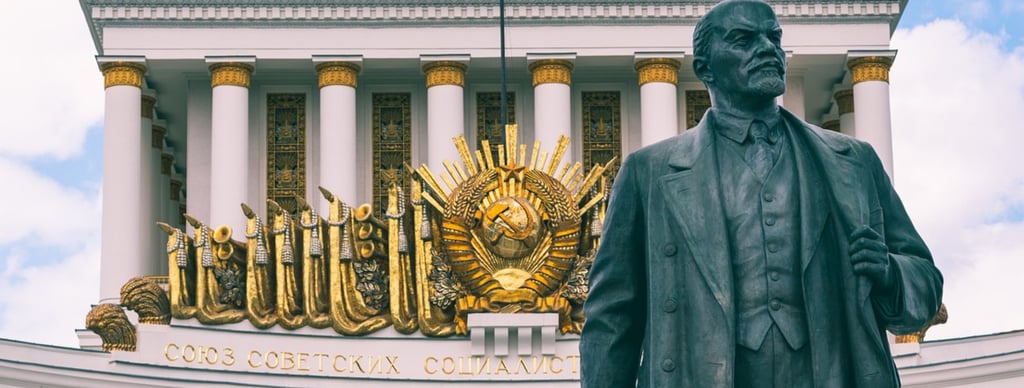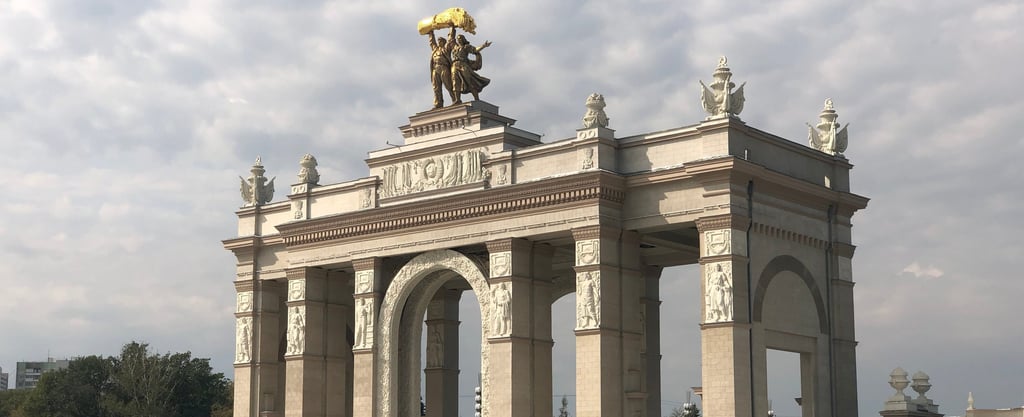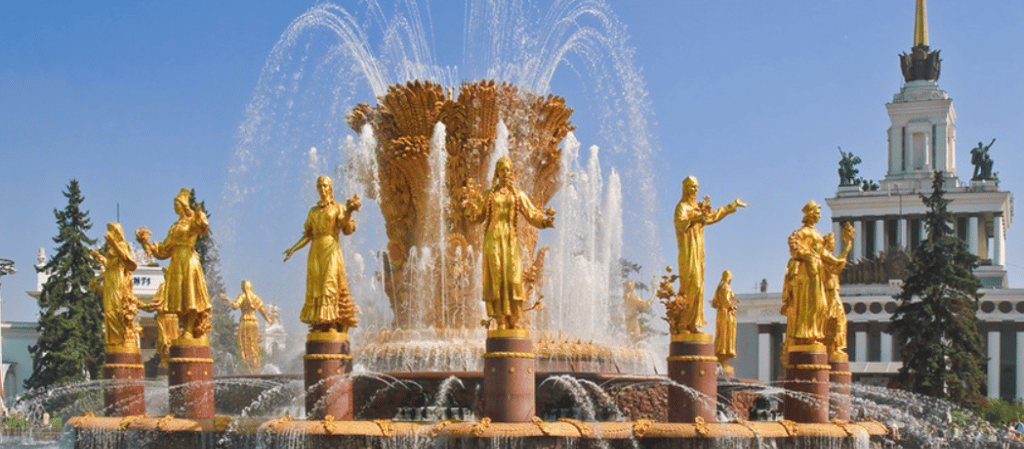VDNKh: A Monumental Dream of Soviet Ambition and Russian Renewal
Welcome to VDNKh, the Exhibition of Achievements of National Economy — one of Moscow’s grandest, strangest, and most fascinating spaces.


A City Within the City
VDNKh is not merely an exhibition center. It is a city within a city — a sprawling 325-hectare complex of avenues, pavilions, gardens, fountains, and monuments, each bearing witness to a century of shifting ideals and aesthetic ambitions.
Few places in the world embody such a potent mixture of propaganda, utopia, nostalgia, and resilience. Built as a showcase of Soviet glory, transformed through post-Soviet chaos, and now reborn as a public cultural and recreational hub, VDNKh stands today as a living palimpsest of Russian history.
Visitors wander its endless promenades not simply to admire architecture or exhibitions, but to encounter the layers of memory and meaning that infuse this monumental space.
The Birth of a Soviet Wonderland
The origins of VDNKh trace back to 1935, when Soviet leader Joseph Stalin authorized the creation of a grand exhibition devoted to Soviet agriculture. The goal was not modest: to demonstrate the superiority of socialism, to educate the masses, and to forge a new visual language for Soviet civilization.
The first iteration, known as the All-Union Agricultural Exhibition, opened in 1939, with temporary pavilions and elaborate dioramas. But the outbreak of World War II halted its development.
After the war, the vision expanded. The exhibition was to become a permanent showcase of all branches of the Soviet economy and culture — a glittering theater of progress. In 1959, the renamed VDNKh opened its gates to the public as a permanent exposition of the “Achievements of the National Economy.”
At its height, VDNKh featured more than 80 pavilions, hundreds of sculptures, gardens, and fountains — all designed to exalt Soviet science, industry, agriculture, and the arts. It was a place where collective farms, factories, and republics could display their finest products and innovations, where citizens could marvel at sputniks and harvesters, at turbines and tractors, at porcelain figurines and cosmic visions.
Stalinist Empire and Socialist Modernity
The architecture of VDNKh offers a staggering survey of Soviet aesthetic ambition. The early pavilions are masterpieces of Stalinist Empire style — grandiose, neoclassical, and laden with symbolic ornamentation.
Marble columns and gilded friezes abound. Statues of workers and peasants strike heroic poses. Motifs of wheat sheaves, red stars, sickles, and hammers adorn every surface. The ensemble was designed not merely to impress, but to construct a mythology of Soviet life.
Later additions in the 1960s and 1970s embraced modernist and futuristic styles, reflecting the technological optimism of the Space Age. Sleek glass facades, steel frameworks, and bold geometric forms signaled a new Soviet vision — one aimed not only at Earth but at the stars.
Today, wandering VDNKh is a journey through this architectural palimpsest: from imperial splendor to brutalist abstraction, from folk motifs to cosmic dreams.
Fountains of Allegory
Among VDNKh’s most beloved features are its spectacular fountains, many of which are themselves monumental works of art.
The Fountain of Friendship of Peoples
At the heart of the main square stands the Fountain of Friendship of Peoples, a dazzling ensemble of gilded maidens representing the 15 republics of the USSR, dressed in national costumes. Set against cascading jets and illuminated sprays, the figures symbolize unity, harmony, and the diversity of the Soviet family.
Visitors gather here in all seasons to admire the play of water and light — a moment of joy and spectacle amid the solemnity of the pavilions.
The Stone Flower Fountain
Inspired by the tales of Pavel Bazhov, the Stone Flower Fountain offers a glittering vision of abundance and beauty. Its intricate mosaic surfaces — crafted from Ural gemstones, colored glass, and metal — shimmer with symbolic richness.
Nearby, smaller fountains and reflecting pools create a sense of rhythm and flow throughout the complex, reinforcing the dreamlike quality of the space.
Pavilions of Memory and Imagination
Each of VDNKh’s many pavilions tells a story — of technological hope, cultural pride, or political will. Though many original exhibits have vanished, the structures remain as powerful symbols.
Pavilion No. 1: Central Pavilion
Crowned by a golden spire and Soviet star, the Central Pavilion is the architectural heart of VDNKh. Once devoted to general economic progress, it now hosts exhibitions of Russian innovation and national culture.
Pavilion of Cosmonautics and Aviation
Perhaps the most iconic of VDNKh’s modern-era spaces, the Pavilion of Cosmonautics celebrates the Soviet space program. Inside, visitors encounter rockets, space capsules, suits, and multimedia displays charting Russia’s cosmic achievements — from Gagarin’s flight to contemporary space exploration.
Outside, the soaring Monument to the Conquerors of Space — a 107-meter titanium obelisk shaped like a rocket plume — pierces the sky, embodying the Soviet will to transcend earthly limits.
Pavilion of Agriculture
Adorned with pastoral motifs and grand murals, this pavilion pays tribute to Soviet agronomy. Though today it hosts diverse cultural events, its aesthetic still speaks of wheat fields, tractors, and collective endeavor.
Republic Pavilions
Once, each Soviet republic maintained its own national pavilion — architectural embodiments of ethnic identity within the socialist framework. Many of these — such as the Uzbek SSR, Belarus SSR, and Kyrgyz SSR pavilions — survive, now repurposed as cultural centers, exhibition halls, or gastronomy hubs.
Their facades, rich in regional ornament, ceramics, and sculpture, offer a rare glimpse into the multinational vision of the Soviet Union.
Practical Information
Location
VDNKh is located in northeast Moscow, easily accessible by public transport.
Address
Prospekt Mira, 119, Moscow, Russia
Opening Hours
The park grounds are open daily, 24 hours.
Individual pavilions and attractions have varied opening hours — typically 10:00 to 19:00.
Admission
Entry to the park is free.
Tickets are required for certain pavilions (e.g., Cosmos Museum, Moskvarium, interactive exhibits).
Tickets can be purchased on-site or online.
Public Transport
Metro: VDNKh Station (Line 6 — Orange Line)
Tram and bus connections also serve the area.
Accessibility
The main avenues and many pavilions are wheelchair accessible.
Special services are available for visitors with limited mobility.
Visitor Services
Guided tours (in Russian and other languages)
Audio guides
Bike and scooter rentals
Cafés, restaurants, and kiosks
Souvenir shops and bookstores
Seasonal entertainment and family activities
For the latest information on exhibitions, events, and services, visit:
https://vdnh.ru


From Decay to Renaissance
Like much of post-Soviet Russia, VDNKh entered a period of neglect and uncertainty after the collapse of the USSR. In the chaotic 1990s, many pavilions fell into disrepair. Commercial kiosks and flea markets invaded the once-majestic avenues. The grandeur of Soviet ambition seemed a crumbling relic.
Yet in the 2010s, a remarkable process of restoration and revival began. Recognizing VDNKh’s unique cultural and historical value, the Moscow city government launched an ambitious program to renovate and reimagine the site.
Painstaking restorations returned gilded sculptures, mosaics, and fountains to their original brilliance. Architectural details long obscured were uncovered and restored. The Central Pavilion, Friendship Fountain, and dozens of republic pavilions were carefully revived.
At the same time, VDNKh embraced a new identity as a multifunctional cultural, scientific, and recreational space. While respecting its Soviet heritage, the complex now hosts a wide range of contemporary activities — from art installations and science festivals to craft markets, concerts, and sporting events.
Today, VDNKh is once again a vibrant part of Moscow life — not a dusty monument to a vanished empire, but a dynamic venue where past and present coexist.
A Space for All
VDNKh’s current mission is remarkably broad. It is at once:
A museum of Soviet architecture and cultural memory
A science and technology center, promoting Russian innovation
A public park, beloved by families and fitness enthusiasts
A venue for international exhibitions and events
A cultural hub, offering art, theater, and gastronomy
A heritage site, preserving unique aspects of 20th-century history
Such diversity makes VDNKh truly a space for all. On any given day, you will encounter:
Elderly Muscovites revisiting the dreams of their youth
Children marveling at rockets and fountains
Couples strolling beneath flowering arches
Cyclists and skaters gliding along wide boulevards
Artists sketching architectural details
Tourists photographing the surreal juxtaposition of styles
This inclusiveness restores VDNKh’s original public character, honoring the ideal — if not always the reality — of the Soviet vision of a shared civic space.
Highlights of the Modern VDNKh
Among the many restored and new attractions, key highlights include:
Cosmos Pavilion and Cosmonautics Museum
A dazzling showcase of Russia’s space heritage, featuring real spacecraft, interactive exhibits, and immersive multimedia experiences.
Worker and Kolkhoz Woman Monument
Designed by Vera Mukhina in 1937, this colossal stainless-steel sculpture of a male worker and a female collective farm laborer striding forward with hammer and sickle remains an icon of Soviet art. Now fully restored, it crowns a dedicated pavilion housing art and history exhibitions.
Aquarium Moskvarium
Opened in 2015, this modern aquarium features marine life from around the world, as well as dolphin shows and educational programs.
Interactive Science Centers
VDNKh hosts several interactive venues devoted to space, robotics, virtual reality, and environmental education — making it a magnet for young learners and families.
Seasonal Festivals
VDNKh comes alive with seasonal events: winter skating rinks, summer music festivals, gastronomic fairs, historical reenactments, and national celebrations.
Gastronomy and Shopping
From traditional Russian fare to international cuisine, VDNKh offers a diverse culinary landscape. Restored republic pavilions now host restaurants, cafés, and cultural shops, celebrating the multicultural heritage of the former USSR.
A Walk Through Time
Visiting VDNKh is like walking through a dreamscape of contradictory visions:
A golden maiden gazes from a fountain built to exalt socialism.
A rocket stands beside a neoclassical colonnade.
Modern graffiti coexists with bas-reliefs of Lenin and collective farmers.
A hipster café operates within a pavilion once devoted to tractor parts.
This surreal blend is what makes VDNKh so compelling. It is a place where the ideology of yesterday meets the creativity of today — where history is not erased, but reinterpreted.




